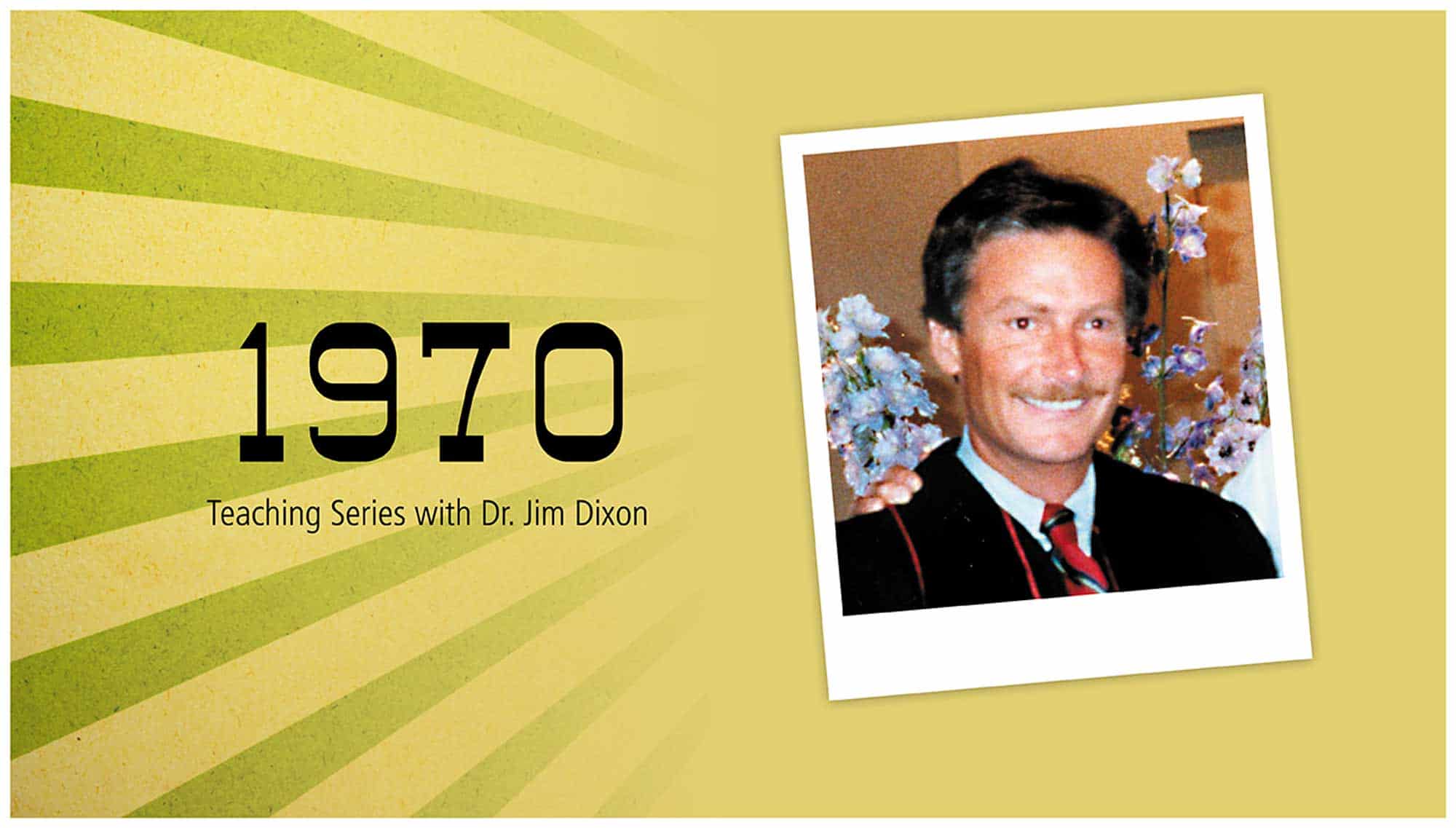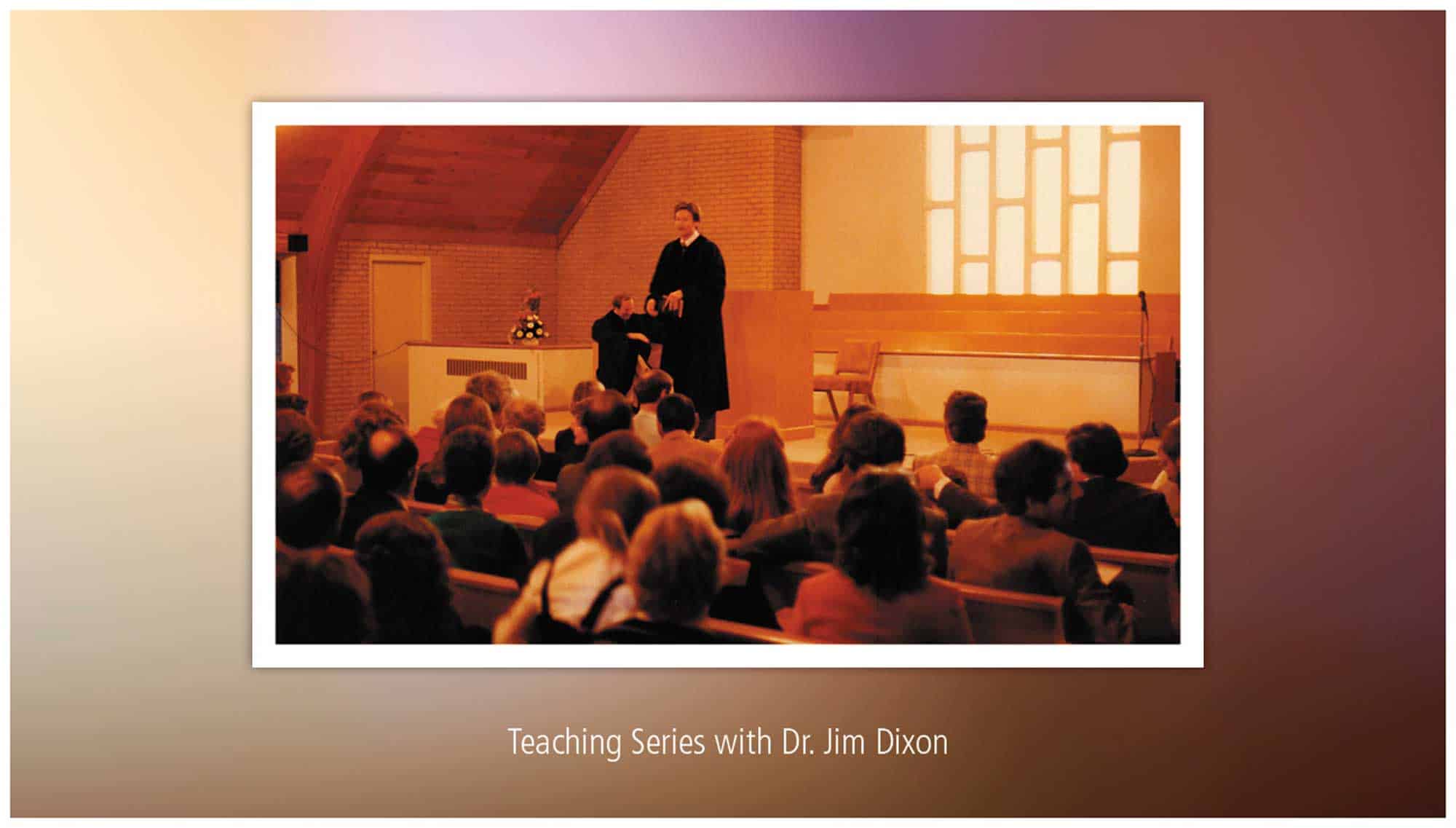BAPTISM
DR. JIM DIXON
1977
Acts 2:38-39, 1 Peter 3:20-21
David was raised in a non-Christian home. At the age of 17 at a Young Life camp, he accepted Jesus Christ as his Lord and Savior. He felt great to be a Christian. He felt cleansed. He felt saved. After a few months, he began talking to another group of Christians, and they told him that he really had not become a Christian. They told him that he still was not saved because he had not been baptized by water. He began to feel insecure. He began to doubt his salvation. He went to the minister at the Presbyterian church where he had been attending, and he asked if he could be baptized. He was baptized by sprinkling in the Sunday morning worship service, and he felt good again. It was great to be a Christian and to be confident of it. The months passed. After six months, he met another group of Christians from another church. They told him that he still was not a Christian. He still was not saved because to be a Christian you had to be baptized, and to be really baptized you had to be baptized by immersion. He began to feel insecure again. He began to doubt his salvation and began to lose his joy. This began a year of struggles. One year later David was baptized by immersion in the river Jordan on an Israel trip.
Unfortunately, the story of David is common among Christian people because there is a great deal of confusion today regarding the meaning and the purpose of baptism by water. From the proof of scripture, God wants us to know that water baptism does not save us. Water baptism is simply an outward sign of an inward reality; it is the inward reality that saves us.
David was saved when he was 17 years old at that Young Life camp. He was saved the moment he asked Jesus to come into his heart. In that moment, he was washed inwardly; he was cleansed. Inwardly, he was reborn. Inwardly, he was baptized. Water baptism is an outward sign, a public confession, that that inward reality has taken place. In the case of infant baptism, for those of you who practice that, it looks forward to the day when that child will confess Christ as Lord and Savior. The sign is given in advance of the reality. But what we should understand is that baptism by water is an outward sign of an inward reality. It is the inward reality that saves us. Having said that, I want to share with you this morning three beautiful truths that are symbolically illustrated through water baptism.
First of all, baptism by water is a beautiful symbol of the truth of salvation. Baptism does not save us, but it is a symbol of the truth of salvation. In the second chapter of the book of Acts and in the third chapter of the book of first Peter, we are told that baptism is a sign of salvation. Peter uses the illustration of Noah and the ark. I am sure you are all familiar with the story of Noah and the ark. Most of you heard it as children. In fact, most people who live in this country are very familiar with the Old Testament Bible stories. They know about Noah and the ark. They know about David and Goliath. They know about Jonah and the whale. They know about Lot’s wife who turned into a pillar of salt. They know about Daniel and the lion’s den. About Shadrach, Meshach and Abednego in the fiery furnace. About Samson and Delilah. They know all these stories.
However, they do not necessarily understand the meaning of all of these stories, and in that regard we are sometimes like children. Children hear the story of Samson, and they like it; but they do not necessarily know what the story means. They like Samson because he fits right in with the Incredible Hulk and Superman, but they do not know what the message of the story is. Do not get a haircut. Stay away from girls. They hear the story of Lot’s wife looking back and turning into a pillar of salt, and they do not really know what that means. One girl commented that her mother looked back and turned into a telephone pole. That is a little different. I heard a story of a Sunday school teacher who was telling her children about the story of Lot. She said, “God told Lot to take his wife and flee out of the city. Lot’s wife looked back and turned into a pillar of salt. Children, do you have any questions?” Of course they had questions. First of all, they wanted to know what happened to the flea because God told Lot to take his wife and flee out of the city.
We are a lot like children. Sometimes we hear these Old Testament stories, and we really do not understand them. Peter wants us to know that the story of Noah and the flood is a story of judgment and salvation. The world in Noah’s day was a world about to be judged. They were a wicked and perverse generation. They were about to be judged by water, but God provided a means of escape and that means was the ark through which Noah and his family, eight persons, were saved. Therefore, the ark became a symbol of salvation in the midst of a wicked and perverse generation. Today, God would have us to know that, once again, we live in a world that is headed for judgment. It is headed for judgment by fire. It is headed for Armageddon. It is headed for the great white throne judgment of the living God.
Once again, God has provided a means of escape. Once again, He has provided an ark, and that ark is Jesus Christ. We come into that ark when we receive Jesus Christ as the Lord and Savior of our lives. When we are baptized by water, Peter wants us to know that symbolically we are celebrating the fact that we have entered this ark, this ark called Christ, and are now recipients of salvation and have escaped the judgment of this wicked and perverse generation.
A week ago, Barb and I were traveling to St. Mary’s Glacier, driving up I-70. We noticed that a large truck had overturned on eastbound I-70. Later we found out that there was a family in that truck—a mother, a father, a little boy, and a little girl. The truck was a runaway according to witnesses, going over 80 miles an hour, and the driver could not control it. The truck turned over and slid 500 feet down the highway. When the family was found, the father and mother were dead. The little two-year-old boy was dead, and the four-year-old girl was in critical condition. The most amazing thing was that that truck driver went right past an escape ramp. He went right past one of those safety exits that are designed to slow down trucks. Investigators did not know why he did it, but apparently he thought that he could control the truck himself.
We live in a world that is like that truck. It is a runaway world, and it is heading for destruction. But God has provided an escape ramp, and that safety exit is our Lord Jesus Christ. Some people think they can handle life on their own, and that pathway leads to destruction and death. There is only one source of salvation, and He is Jesus Christ. There is no other name under heaven given among men whereby we may be saved (Acts 4:12). When we are baptized with water, we celebrate the fact that we have entered into this salvation; and the beautiful thing for us as Christians is that God continues to provide for us. He continues to protect us once we have entered that realm of salvation.
I thank God because three weeks ago my mom and dad left Denver and were driving back to California. They were going through Glenwood Canyon, and my father fell asleep at the wheel. My mother was already asleep. They crashed into the cliff on the right side of the road. That is a praise because if they had gone over on the left side, they would have gone over the bank and into the river. My father was jarred awake. The car was out of control. It went across the road and onto the ledge of the left side. He was able to pull it around just before it went off the cliff. His Mercedes is not in very good shape. We praise God that God protected him. I honestly believe that God continues to protect us until our ministry is full. We have entered into this realm of salvation, and it is eternal. Baptism is a celebration. We have entered into His protection, His safety, and His salvation.
Secondly, Peter tells us that water baptism is a beautiful symbol of cleansing. It is a symbol of washing. In the Bible we are told that baptism is the washing of regeneration. Peter says,”Repent and be baptized, every one of you . . . for the forgiveness of your sins” (Acts 2:38). Baptism symbolizes forgiveness, washing, and cleansing. It symbolizes being pure within.
When Barbara and I came back from Missouri, the person who was taking care of our house told us that our dog had run away. At first I felt kind of good about that because I am not really into dogs; but Drew and Heather were devastated, and Barbara and I knew we had to do something. The dog had been gone for three days, but we continued to look. Finally, after ten days, we found the dog at the Englewood pound. They charged $2 a day. The dog did have a private room, so we appreciated that; but it cost us $38 total, counting all the fees to get our dog ransomed. We ransomed that dog.
The first thing we did, after we got our dog out of the pound, was to take our dog to the vet. We had our dog clipped and washed and groomed. Then we brought it safely home. That is what God offers to do for each and every one of us through Christ ransoming us. The price, however, is a lot more than $38. It cost Him His life. We have been ransomed from the ways inherited by our fathers, not by perishable things such as silver and gold, but by the precious blood of Jesus Christ (1 Peter 1:18-19). Having ransomed us, He then washes us. He cleanses us within, and He fills us with His Spirit and brings us safely home.
Baptism is a celebration of that cleansing. No group of people in biblical times was in greater need of outward cleansing than people with leprosy. It is not possible for you and me living in 20th century America to know what life for a person with leprosy was like. A person with leprosy was literally banished from the fellowship of others. People with leprosy dwelt alone or dwelt in packs roving the wilderness. If they ever drew near to a healthy person, they had to shout out, “Unclean. Unclean.”
There were two types of leprosy. There was tubercular leprosy, and it began with a strange, aching feeling in the joints and tiredness. The skin began to form spots of discoloration and blotches. Nodules began to form upon the skin, and the skin began to thicken so that people with leprosy began to look as though they were not human. After a period of time, those nodules would begin to ulcerate and would stink. It would reach a point where the person could not even breathe because even the vocal cords had ulcerated. The poor person became a mass of ulcers. The disease led to a coma and ultimately death. The process took a period of about ten years.
There is also anesthetic leprosy, which began in a similar way, attacking the joints with a vague discomfort. Then it would attack the central nervous system. There was a loss of feeling, a loss of sensation in the limbs, a numbness; and then it would attack the muscles and the tendons of the body. The tendons would contract so that hands became like claws. After a period of time, a hand could fall off or the foot might fall off so that there was only a stump for a limb. That type of leprosy would sometimes last thirty years.
Most biblical cases of leprosy were a combination of tubercular and anesthetic leprosy. If anyone needed the touch, the cleaning touch of the Lord Jesus Christ, it was a person with leprosy. You might recall that moment after our Lord Jesus Christ had delivered the Sermon on the Mount. He was in a small town in Galilee. A person with leprosy came up to Him and fell at His feet with his face in the dirt. That person had no right to do that because there were laws in Palestine. A person with leprosy could not come within 150 feet of a healthy person. But this person was desperate. He was bold, and he fell at Christ’s feet. He cried out, “Master,” and said, “If you will, you can make me clean” (Matthew 8:2). Jesus reached out and He touched the untouchable. He said, “I will. Be clean.” Instantly that man was cleansed. He was healthy, and he was normal.
Each and every one of us are just like that person with leprosy, inwardly. We all have leprosy in our souls and spirits. That is the human condition. But when we come to Jesus Christ and we cry out, “Master, if you will, you can make me clean,” He puts His hand upon us and says, “I will. Be clean.” We are washed inwardly, cleansed inwardly. So baptism by water is a beautiful celebration of this inward cleansing at the touch of the Master’s hand. I do not think anything is more tragic than seeing a person who is unable to find cleansing, unable to alleviate guilt, unable to feel washed.
Last Monday night, Barb and I, Bob and Allie, and some other friends from the church went to the Denver Center to the World Theater Festival. We saw the play Einstein, the story of Albert Einstein. Certainly by this world standards, he was a great man, a brilliant man. He had been a professor of theoretical physics at the University of Zurich in Switzerland, and his scientific discoveries literally astounded the men and women of his time toward the close of his life. In 1952, this Jew, who was born in Germany, was invited to become the president of the newly formed state of Israel. Yet for all of his greatness and for all of his brilliance, his personal life was a tragedy. His two marriages were failures. His children lived tragic lives; one of his sons had schizophrenia. Albert Einstein had trouble forming friendships. Even his scientific discoveries, particularly his discovery of the conversion of mass to energy, his specific theory of relativity, was used primarily for the formation of the first atomic bomb that was dropped on Hiroshima. Towards the close of his life, he was guilt ridden. He cried out for mercy and for cleansing and for washing, but he could not cleanse himself. He was a Jew without a messiah, and it was tragic.
We who believe in Jesus Christ have found the one source of cleansing, the one person who can wash us within the one source of forgiveness, the Messiah, the Son of God, Jesus Christ. When we ask Him to come into our heart, He comes in and washes us. Baptism is a celebration of that washing.
Thirdly, and finally, Peter tells us that water baptism is a beautiful symbol of death and resurrection. In the sixth chapter of the book of Romans, Paul tells us that when we go under the waters of baptism, symbolically, we are being crucified and buried with Christ. We die to ourselves. We die to self-reign. The old nature is crucified and buried under that water. When we rise out of the waters of baptism, we rise as a new creation. We rise as members and citizens of a new kingdom. We have a new life. We enter into the resurrected life of Jesus Christ, and we are recipients of all the privileges and all the blessings of that life. Baptism, biblically, is viewed as symbolically expressing the death of the old nature, the death of the sin nature, and resurrection to Christ.
Two weeks ago, or actually it was about a week ago, I was on Parker Road. I was going to turn onto the freeway, onto I-225. As I got into the righthand turn lane, a car cut me off and almost sideswiped the front of my car. I was not in a particularly good mood anyway, and I honked my horn. The driver turned around and gave me the right finger of fellowship. I was enraged. If I had been in a destruction derby or some kind of bumper car, like at an amusement park, I would have liked to have put my car right into that car. It does not take much for the old nature, the sin nature, to rise up.
There is a sense in which when we accept Christ as Lord and Savior that old nature is crucified and buried. The righteousness of Jesus Christ is imputed to us. But there is also a sense in which we must undergo the process of sanctification in that old nature. This sin nature is being crucified daily.
A few years ago, Bob preached a sermon at another church. At that time, Bob had a beard. There was a man in that church who did not like beards. In fact, he could not stand beards. After Bob was done preaching, this man wrote Bob a horrible letter. He was serious. This man was angry. He went through all the history of evil people who had worn beards and listed them. He went into the realm of the supernatural and pointed out that Satan has a beard. (I do not know that that is particularly biblical.) Then he went into the animal kingdom, and he said the filthy laughing hyena has a beard. When you get a letter like that, you are somewhat amazed; but you are also a little angry. You would like to call the person up and ask him where he got his lobotomy or at least you would like to call the guy and give him a few better historical examples like Abraham Lincoln or perhaps our Lord Jesus Christ himself who had beards. But Bob did something very beautiful. Bob went to that guy and sought reconciliation and friendship because that is what Jesus Christ has told us to do.
We die to self, and we live to Christ. That is symbolized in baptism. I am sure many of you heard the story of Charles Spurgeon, one of the great preachers of the past. One day he got a hate letter in the mail. This letter had one word in it and was written in big letters. It just said, “FOOL.” Spurgeon was enraged when he saw the letter. He went to church the next Sunday and stood before the congregation. He held this letter up and said, “Many times I have received a letter where the person wrote a message and forgot to sign his name. This is the first time I received a letter where the person signed his name and forgot to write the message.”
Spurgeon had a great sense of humor, but I am sure that man was sitting in the congregation and there was a little vindictiveness in that. The old nature, even in a great man like Charles Spurgeon, was still there. It must be crucified daily. We have been called to a new life in Christ. The apostle Paul wrote to the Christians at Galatians and said, “The works of the flesh are immorality, impurity, licentiousness, idolatry, sorcery, enmity, strife, jealousy, anger, selfishness, dissension, envy, drunkenness, carousing, and the like. I tell you now, and I’ve told you before, that those who practice such things will never inherit the kingdom of heaven. The fruit of the Spirit is love, joy, peace, patience, kindness, goodness, faithfulness, gentleness, and self-control against such, there is no law, for those who belong to Jesus Christ have crucified the flesh with its passions and desires (Galatians 5:22-23).
Baptism symbolizes that we have crucified the flesh with its passions and desires. When we go under the water, the old nature is gone. When we come out of the water, we live to Christ. This process of sanctification shows that it is an ongoing work, but we celebrate the victory in that moment of baptism. So baptism is a beautiful symbol—a symbol of salvation, a symbol of cleansing, and a symbol of death and resurrection.
Shall we pray? Father, thank You so much for Your love for us. Father, thank You that in this world that is heading for destruction You have provided a means of salvation. You have provided an ark. You have provided your only Son, our Lord Jesus Christ. Lord, if there are individuals here who do not know Jesus, who have never invited Him into their lives to be their Lord and Savior, I pray, Lord, that they might do that today; and then Lord that they would seek water baptism to celebrate symbolically the beauty of that truth. Thank you, Lord, that baptism symbolizes these three beautiful gifts. They symbolize salvation, cleansing, death and resurrection. Lord, we love You. We want to serve You throughout our lives. We praise You for your goodness, for Your mercy, and for Your grace. We pray all these things in the matchless name of Jesus Christ. Amen.



